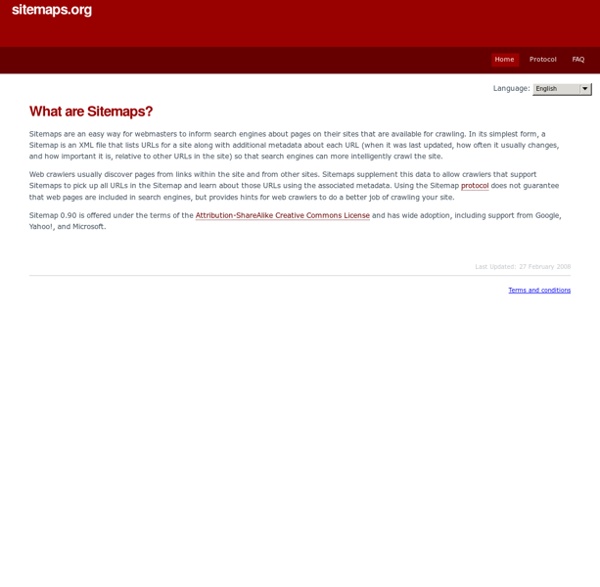Specify your canonical
Carpe diem on any duplicate content worries: we now support a format that allows you to publicly specify your preferred version of a URL. If your site has identical or vastly similar content that's accessible through multiple URLs, this format provides you with more control over the URL returned in search results. It also helps to make sure that properties such as link popularity are consolidated to your preferred version. Let's take our old example of a site selling Swedish fish. Imagine that your preferred version of the URL and its content looks like this: However, users (and Googlebot) can access Swedish fish through multiple (not as simple) URLs.
sitemaps.org - Protocol
Jump to: XML tag definitions Entity escaping Using Sitemap index files Other Sitemap formats Sitemap file location Validating your Sitemap Extending the Sitemaps protocol Informing search engine crawlers This document describes the XML schema for the Sitemap protocol. The Sitemap protocol format consists of XML tags. All data values in a Sitemap must be entity-escaped. The file itself must be UTF-8 encoded. The Sitemap must:
Introducing Rich Snippets
Webmaster Level: All As a webmaster, you have a unique understanding of your web pages and the content they represent. Google helps users find your page by showing them a small sample of that content -- the "snippet."
About Sitemaps - Webmaster Tools Help
What is a sitemap? A sitemap is a file where you can list the web pages of your site to tell Google and other search engines about the organization of your site content. Search engine web crawlers like Googlebot read this file to more intelligently crawl your site.
The Original Meta Tags Code Generator
The Original Meta Tags Code Generator It's not that difficult to make meta tags but we've made it simple for you by offering you this free meta tags wizard or generator (Free Meta Tag Builder & Fetcher). By filling out all the sections of this code generator wizard it will create perfect meta tags. These meta tags can then be put in the html or php source of your website.
Rich snippets: testing tool improvements, breadcrumbs, and events
Webmaster Level: All Since the initial roll-out of rich snippets in 2009, webmasters have shown a great deal of interest in adding markup to their web pages to improve their listings in search results. When webmasters add markup using microdata, microformats, or RDFa, Google is able to understand the content on web pages and show search result snippets that better convey the information on the page. Thanks to steady adoption by webmasters, we now see more than twice as many searches with rich snippets in the results in the US, and a four-fold increase globally, compared to one year ago. Here are three recent product updates.
Sitemaps
The Sitemaps protocol allows a webmaster to inform search engines about URLs on a website that are available for crawling. A Sitemap is an XML file that lists the URLs for a site. It allows webmasters to include additional information about each URL: when it was last updated, how often it changes, and how important it is in relation to other URLs in the site. This allows search engines to crawl the site more intelligently. Sitemaps are a URL inclusion protocol and complement robots.txt, a URL exclusion protocol.
the secrets of search engines html meta tags
Over 80% of all people use search engines to find information on the internet. About 60% of them use the search engine Google. Hardly anyone knows your internet domain name but often they do know the business you are in.



